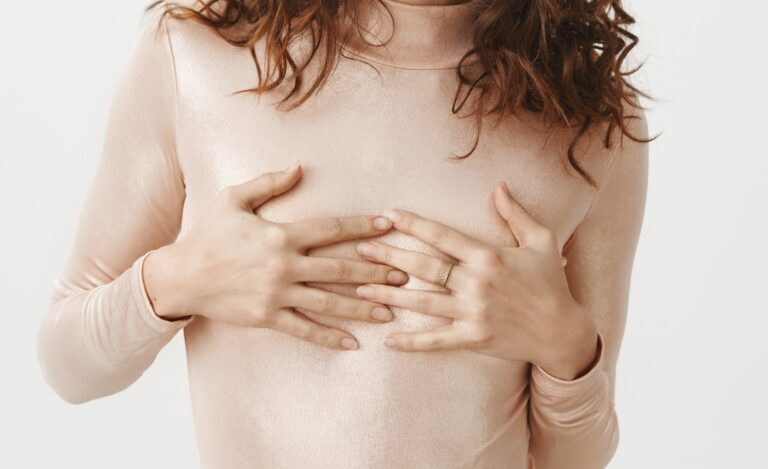Galactocele vs clogged duct : Know the difference?

Galactoceles, or lactocoeles are fluid-filled sacs that can develop in your breast tissue. They often occur in lactating women but can also affect non-lactating individuals. Now, I know this might sound concerning, but bear with me. I’m going to break down what you need to know!

In this article, we will explore the definition or meaning of galactocele, its symptoms, diagnosis, available treatments, and potential complications, and address common questions regarding this condition.
What is galactocele?
Galactocele is a “benign breast condition that occurs when milk becomes trapped and forms a cyst within the breast tissue”.
The cyst typically develops during lactation or shortly after weaning, and it may persist for weeks or months, if left untreated.
Are galactoceles painful?
Galactoceles are usually painless and often detected during a physical examination or through imaging techniques such as ultrasound or mammography.
What are the sign and symptoms of galactocele?
Galactoceles often present with specific symptoms related to breastfeeding and milk production. Common symptoms of a galactocele include:

- Breast Lump: A noticeable lump or mass in the breast that feels round, smooth, and often firm to the touch. It can range in size from small to several centimeters in diameter.
- Pain or Discomfort: Some individuals might experience localized pain, tenderness, or discomfort around the area of the lump. This discomfort can be exacerbated when breastfeeding or expressing milk.
- Swelling: The affected breast might appear swollen or engorged.
- Visible or Palpable Mass: The lump may be visible on the surface of the breast. It may be more prominent when the breast is engorged with milk.
- Fluid Leakage: In some cases, the lump may cause milk to accumulate in the duct, leading to a localized area of engorgement. This can result in leaking milk from the nipple.
- Pain During Breastfeeding: Breastfeeding or milk expression may be associated with pain or discomfort due to the presence of the lump and the blockage of milk flow.
NOTE: It’s important to note that any breast lump should be evaluated by a healthcare professional to rule out other potential conditions, including more serious ones like breast cancer.
How can I tell if I have one? Galactocele vs plugged duct
It is important to differentiate galactocele from plugged ducts, as both conditions can present with similar symptoms.
Galactocele and plugged duct are both related to the breast and milk production, but they are different conditions. Here’s a comparison between the two:
| Galactocele | Plugged Duct | |
| Nature | A galactocele is a benign cystic structure that forms when milk accumulates in a blocked milk duct. It’s essentially a cyst filled with milk. | A plugged duct occurs when milk flow is obstructed within a milk duct. This can be due to factors such as poor milk drainage, tight clothing, skipped feedings, or pressure on the breast. |
| Symptoms | Common symptoms of a galactocele include a round, smooth, and firm breast lump, often accompanied by pain, discomfort, and swelling. The lump may be visible or palpable, and fluid leakage can occur. | Symptoms of a plugged duct include a localized, tender lump in the breast. The area around the lump might be red and sore. The skin might feel warm, and discomfort may increase during breastfeeding or pumping. |
| Treatment | Treatment options for a galactocele include observation Supportive careProper breastfeeding techniquesMilk expressionWarm compressesIn some cases, medical procedures like needle aspiration or surgical removal. | Treating a plugged duct involves: Frequent breastfeeding or milk expressionMassaging the affected areaApplying warm compresses Ensuring proper latch and positioning during breastfeedingResting as much as possible. |
In summary, a galactocele is a milk-filled cystic lump that forms due to a blocked milk duct, whereas a plugged duct refers to the blockage of a milk duct that causes pain, tenderness, and a lump in the breast.
Treatment and Prognosis
The treatment options for a galactocele typically depend on the size of the lump, the presence of symptoms, and the individual’s breastfeeding goals. Here are some common approaches that healthcare professionals might consider:
- Observation and Supportive Care: If the galactocele is small, not causing significant discomfort, and not affecting breastfeeding, a healthcare provider might recommend a wait-and-see approach. Regular breastfeeding or milk expression can help manage the milk accumulation and gradually reduce the size of the lump.
- Breastfeeding Management: Ensuring proper breastfeeding techniques and positioning can help improve milk flow and prevent further blockages. Using warm compresses and gentle massage on the affected area before breastfeeding or pumping can also be helpful.

- Milk Expression and Drainage: Regularly emptying the breast through breastfeeding or pumping can prevent milk from pooling and accumulating in the blocked duct. This can help alleviate the symptoms associated with the galactocele.
- Manual Expression: Some individuals may find relief by manually expressing milk from the affected breast. This can help reduce the size of the lump and alleviate discomfort.
- Needle Aspiration: In some cases, a healthcare provider may perform a procedure called needle aspiration. This involves using a thin needle to drain the accumulated milk from the galactocele.

- Surgical Removal: If the galactocele is large, causing significant discomfort, or not responding to other treatments, surgical removal might be considered. This is typically a last resort and is only recommended when other options have been exhausted.
It’s crucial to work closely with a healthcare provider, such as a lactation consultant or a breast specialist, to determine the best course of action based on the individual’s specific circumstances. Self-diagnosis and self-treatment are not recommended. If you suspect you have a galactocele or any other breast-related concern, seek medical advice promptly.
Will galactoceles go away on their own?
Galactoceles have the potential to resolve on their own without any intervention, particularly after weaning. However, this process can take several weeks or even months. Monitoring the size and any associated symptoms is crucial, and consulting a healthcare professional is recommended for appropriate guidance and to rule out any complications.

Is there any home treatment for galactocele?
While it’s always recommended to consult a healthcare professional for proper diagnosis and guidance. Still there are some home-based strategies that might help alleviate the symptoms associated with a galactocele. Keep in mind that these approaches are not a substitute for medical advice, especially if the symptoms persist or worsen. Here are some home treatments that could be considered:
- Breastfeeding or Milk Expression: Regularly breastfeeding your baby or using a breast pump to express milk can help prevent milk from accumulating. Ensure proper positioning and latch to optimize milk flow.
- Warm Compresses: Applying warm compresses to the affected breast before breastfeeding or pumping can help improve blood flow. This may help soften the lump and make it easier to express milk.
- Gentle Massage: Massaging the area gently can stimulate milk flow and help dislodge the blockage. Massage from the area behind the lump towards the nipple to encourage milk drainage.
- Manual Expression: You can manually express milk by using your fingers to apply gentle pressure to the affected area. This can help release trapped milk and reduce the lump’s size.
- Comfortable Clothing and Bras: Wearing loose, comfortable clothing and a well-fitting bra can prevent unnecessary pressure on the breasts, which might worsen the symptoms.
- Pain Relief: Over-the-counter pain relievers like acetaminophen or ibuprofen (following recommended dosages) can help manage pain and discomfort associated with the galactocele.
- Hydration and Nutrition: Staying well-hydrated and maintaining a balanced diet can support overall breast health and milk production.
Remember, it’s important to monitor your symptoms closely and seek medical attention. With time, you can also develop signs of infection such as fever, redness, or warmth around the lump.
Can galactocele turn into cancer?

Galactocele itself is a benign condition and does not have a direct association with breast cancer. However, it’s important to note that any new breast lump or change in breast tissue should be evaluated by a healthcare professional.
What are the complications of galactocele?
While galactocele is generally a benign condition, there can be potential complications. In some cases, the cyst may become infected, leading to the development of an abscess.
Signs of infection include redness, warmth, pain, and fever. If any of these symptoms occur, prompt medical attention is necessary to prevent further complications.
Conclusion
Galactocele is a relatively common benign breast condition that occurs during lactation or post-weaning. While it usually resolves on its own, some cases may require medical intervention. If you suspect a galactocele or experience breast-related concerns, it is essential to consult a healthcare professional for a proper diagnosis and individualized treatment plan. Early detection and appropriate management can ensure optimal care and peace of mind for lactating women.
Frequently asked questions
- Can a galactocele cause breastfeeding difficulties?
Yes, the presence of a galactocele can put pressure on the surrounding breast tissue and milk ducts, leading to potential blockages or reduced milk supply. If you are experiencing breastfeeding difficulties or suspect a galactocele, it is advisable to consult with a lactation consultant or healthcare professional.
- Is galactocele more common in first-time mothers?
Galactoceles can occur in women who have previously given birth as well as in first-time mothers. It can develop in any lactating woman, regardless of their breastfeeding history.
- Are galactoceles preventable?
There are no specific measures to prevent galactoceles from occurring. However, taking steps to maintain good breastfeeding hygiene, ensuring proper breast emptying during feeding or pumping sessions, and promptly addressing any concerns or issues that arise during lactation may help minimize the risk.
Note: The information provided in this blog is for educational purposes only and should not replace professional medical advice. If you have specific concerns or questions about galactocele or any breast-related issues, please consult a healthcare professional.













+ There are no comments
Add yours